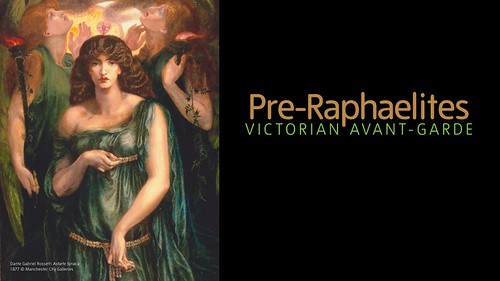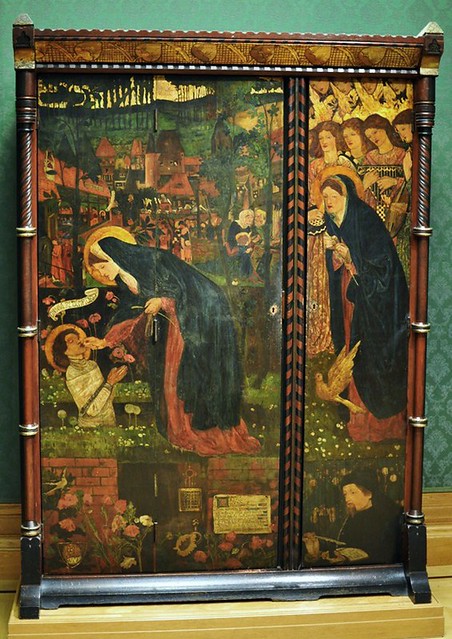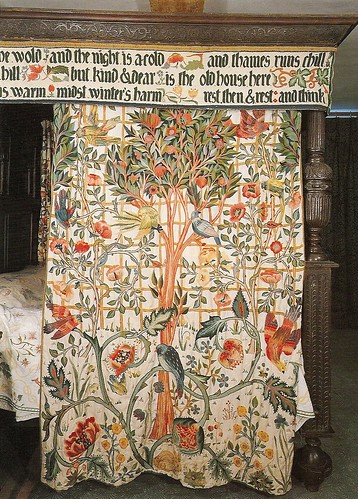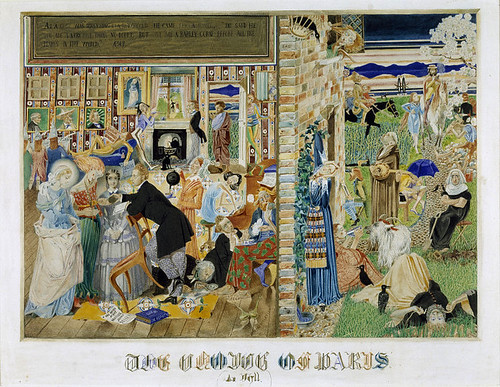
In contrast to previous Pre-Raphaelite surveys, this exhibition juxtaposed paintings with works in other media including the applied arts, showing the important role of the Pre-Raphaelite Brotherhood in the early development of the Arts and Crafts movement and the socialist ideas of the poet, designer and theorist, William Morris (1834-1896). Bringing together furniture and objects designed by Morris‘s firm, of which many Pre-Raphaelite artists were part, the aim was to depict how Morris’s iconography for British socialism ultimately evolved out of Pre-Raphaelitism.
Some of the works I had seen at exhibitions previously. I was thrilled to see more of a female presence at this exhibition, including some previously unseen works by Elizabeth Siddal.

Source
Cabinet Decorated with Scenes from ‘The Prioress’s Tale’, Philip Webb and Edward Burne-Jones. This cabinet, designed by Philip Webb and decorated by Burne-Jones, is made from oak and deal and painted in oil. Burne-Jones gave it to William Morris as a wedding present on his marriage to Jane Burden in 1859. This cabinent stood in the Morris' bedroom at Red House (that I also visited).
It was exciting to see examples of arts and crafts textiles in a Pre-Raphaelite exhibition, showcasing the multi-disciplinary approach of the movement and its followers. I did get emotional over a bed though...


This bed is usually to be found at Kelmscott Manor, the pattern is "Kelmscott Tree" The bed pelmet, in this pattern, was designed by May Morris, and embroidered by Lily Yeats and Ellen Wright (1891-3). Lily Yeats worked for Morris & Co., under May Morris for six years, some of the most difficult years of her life. Her letters to her family mention May and her temper, the difficulty of working for her, frequently referring to her as a "gorgon". For me it was thrilling to look upon something that Lily had probably spent weeks bent over, there's something about the intimacy of a historic textile that really appeals to my senses and emotions.
One of the standouts for me was the female representation in the exhibit, though not significant it's inclusion is necessary. Seeing the women as creative individuals and not just the rigid catalyst for a man's creativity.

Lady Clare, Elizabeth Siddal, 1857.
This drawing illustrates Tennyson's Lady Clare, in which the heroine's natural mother begs her to conceal her humble origin, lest Lord Ronald withdraw his offer of marriage.

Lady Affixing a Pennant to a Knight’s Lance, Elizabeth Siddal, 1856

The Lady of Shalott, Elizabeth Siddal, 1853. This is the 4th version of the Lady of Shalott, and the only one done by a woman. Here, Siddal shows her at the moment she looks out the window. The woman is dressed simply, unadorned and unsexualised, a completely different perspective to the image of the Lady of Shalott we are acquainted with, like the Holman Hunt below.
Some of the above were purchased with assistance from Sir Arthur Du Cros Bt and Sir Otto Beit through the Art Fund in 1916.
The exhibition wasn't simply self-congratulatory, also included was some contemporary satire, courtesy of Florence Claxton (1840-79). Claxton was an English artist and humorist, most notable for her satire on the Pre-Raphaelite movement. She also wrote and illustrated many humorous commentaries on contemporary life.

Claxton's The Choice of Paris: An Idyll (c. 1860), a satire on the Pre-Raphaelites. (Click to enlarge)

Isabella and the Pot of Basil, William Holman Hunt, 1868 (completed).
The painting illustrates a poem by John Keats: Isabella, or, the Pot of Basil. In it, Isabella and Lorenzo fall in love. Her brothers kill Lorenzo. After searching for and finding his body, Isabella buries his head under a plant of Basil. Hunt used his wife Fanny as the model. She was pregnant at the time and gave birth to their son in August 1866, but died in December of that year, leaving Hunt to complete the painting after her death. The juxtaposition of the representation of life and death in this painting twinges it with sadness.

King Cophetua and the Beggar Maid, Edward Burne-Jones, 1884
Taken from a Medieval romance which tells the legend of the prince Cophetua and his unorthodox love for the beggar Penelophon. Cophetua was an African king known for his lack of any natural sexual attraction to women. One day while looking out a palace window he witnesses a young beggar (Penelophon) suffering for lack of clothes. Struck by love at first sight, Cophetua decides that he will either have the beggar as his wife or commit suicide. Obviously Burne-Jones has included a (sheer) sheath of clothing for the sake of Victorian propriety in his depiction of the myth.
This psychedelic depiction of the Lady of Shalott by Holman Hunt was one of the penultimate paintings in the exhibition, it was absolutely stunning in scale and style. Seeing it I experienced one of those magical gallery specific moments where a painting renders you speechless, and in response you can only sit and drink it in.

The Lady of Shalott, William Holman Hunt, (begun in 1886 and finally exhibited in 1905) on loan from the Manchester Art Gallery.
She left the web, she left the loom,
She made three paces through the room,
She saw the water-lily bloom,
She saw the helmet and the plume,
She look'd down to Camelot.
Out flew the web and floated wide;
The mirror crack'd from side to side;
'The curse is come upon me,' cried
The Lady of Shalott.
[Alfred, Lord Tennyson, The Lady of Shalott (1842)]
Some interesting further reading...
Letter from Rossetti to his brother while his “pupil” [Elizabeth Siddal] uses his studio
The Ballad of King Cophetua and the Beggar Maid
Pre-Raphaelitism and Illustration, Florence Claxton
LizzieSiddal.Com
The Pre-Raphaelite Sisterhood

This entry is such a dream, Zoe! I absolutely loved it - love how you record what inspired the paintings and your reaction to them. It seems like such a wonderful exhibition and although I am a Pre-Raphaelite novice, it is something I would dearly love to view!
ReplyDeletemaeve you always have the loveliest things to say!! i didn't want to list all the paintings i'd seen, just some of the more interesting ones i'd seen - esp the lizzie siddal ones! i think its a very accessible exhibition, such a pity all these things are in london! but there you go!
DeleteWow I am so jealous you got to see that exhibition! Pre-raphaelite is my favourite art movement by miles, Waterhouse being my absolute favourite. I love the Lady of Shalott, my dad used to read that and other Tennyson stuff to me when I was little I remember the eerie rythym/pace of the words really affecting me to the point that I found the poem quite scary!
ReplyDeleteSuch an eerie poem! I love the arts and crafts movement. I went to see the Waterhouse exhibition in National Gallery a few years ago, that was an incredible experience, seeing them in the flesh, some of the surprising in their scale!
DeleteI read your blog and don't usually comment, but I have to say I loved this entry! I've been a huge fan of Pre-Raphaelite art ever since I visited the Tate Britain a few years ago. I wish I could have gone to this exhibit but alas, I am on the wrong continent. I love the William Holman Hunt painting and the poem as well...there is actually another (very similar) version of that painting at the Wadsworth Atheneum in Connecticut, where I live. It's my favorite painting there and every time I go there, I take extra time to stare at the painting...good art just is captivating. I have a postcard of it on my wall right now haha. :)
ReplyDeleteThank you Lindsay, I feel I need to put these things somewhere for my own benefit and if someone else enjoys it, its a plus! I'm very, very forgetful, so I like going back and having a visual reference :) This was in fact my first time at Tate Britain, there's so much to see and do in London that its difficult to prioritise, but this exhibition was a must! Is the painting by Holman Hunt too? I was floored when I seen it, i must have seen it in books before, but nothing prepared me for the scale and colours!
DeleteYes, it's by Holman Hunt as well. What's funny is that it was on my copy of the Norton Anthology of Victorian Literature (or something like that) when I was at university, and I noticed it said it was in the Wadsworth Atheneum art museum not far from where I lived, so I when I went to the museum the next time, I looked for it. I didn't realize there was another version of that painting in England. Here's a link to it:
Deletehttp://www.thewadsworth.org/ladyofshalott/
I took myself off to this exhibition too, last time I was in London - and absolutely loved it. What a joy to revisit parts of it through your wonderful post here. I almost felt I was wandering around and contemplating for a second time. Mind you I did spend a disproportionate (and very lingering) length of time there. I was glad the attendants didn't enforce the time limit! thank you for adding in suggestions for extra reading too.
ReplyDeleteThank you for your kind comment! I'm rather a fan of yours! I did too, despite the crowds, one has to take things in and i'm rather stubborn, I don't like to be carried away by the crowds, and I try to assert my place without being too much of a nuisance! I like to read around on these things, and its as much for my own reference that i include the extra reading to go back on afterward.
Deletethanks Ingrid, I didn't actually - the bed pictures are from the Ashmolean museum website and the picture of the wardrobe was taken from a blog (in Spanish) - not entirely sure they had permission to take photos either!
ReplyDeleteWhat beautiful reporting. I've been told to go see this, I want to see it if it's still on. There was also a TV drama recently about the pre-Raphaelites that I missed or ignored for one reason or other.
ReplyDelete